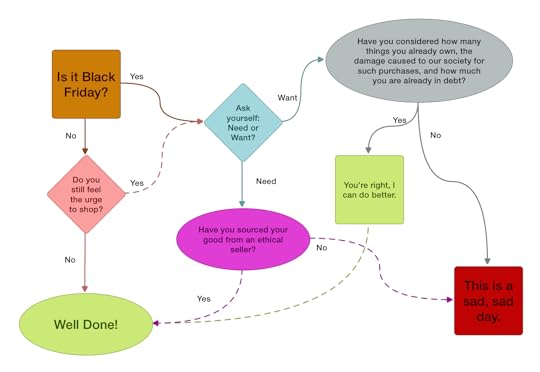Dan Pontefract's Blog, page 33
December 15, 2015
Is Your Corporate Culture The Root Cause Of Bad Meetings?
Several moons ago, I was asked to participate in a meeting.
Nothing new there. After all, a report by Atlassian suggests employees attend 62 meetings per month. In the US alone that works out to roughly 11 million meetings being held every single day. Some days it feels as though I’m attending most of those 11 million. Worse, however, is the fact meetings are very unproductive costing organizations an incredible $37 billion annually due to various factors.
The meeting I was invited to was the kick-off to a project to consolidate several redundant processes into something that was more effective. The idea came from a couple of my peers, not from a senior leader. It sounded like a good plan to me. I’m all for things being more efficient. It was great to see the idea surface from a bottoms up approach, too.
 But what happened next is all too familiar in today’s workplace. Meetings are an important part of being collaborative, however, getting to the actual meeting (and the point at which the collaboration ought to occur) can at times become rather cumbersome. The meeting itself can be quite useless as well.
But what happened next is all too familiar in today’s workplace. Meetings are an important part of being collaborative, however, getting to the actual meeting (and the point at which the collaboration ought to occur) can at times become rather cumbersome. The meeting itself can be quite useless as well.
The meeting I had been invited to was dealing with “sensitive matters”, so the organizers decided a “pre-planning meeting” was needed to first establish the agenda. Not so shocking, in hindsight, because a Clarizen/Harris poll conducted in 2015 found 4.6 hours was used each week by employees to prepare for meetings.
A small sub-group was asked to participate in this pre-planning meeting, including me. The organizers felt compelled to invite several senior leaders (Read: our bosses) to the “sensitive matters meeting” so apparently we had to get our stories straight first. That 60-minute meeting did not result in the desired outcome, so another pre-planning meeting was set to finalize the agenda. In total, 120 minutes were used to create the agenda for the actual “sensitive matters meeting” with the larger team that was to include several high ranking senior leaders. This was ironical to me given the meeting we were trying to set up in the first place was tasked with reducing various redundant efficiencies, and here we were being inefficient. But I digress.
The “sensitive matters meeting” was now (thankfully) set, and we were ready to proceed.
There were more attendees required in the “sensitive matters meeting” than the “pre-planning meeting” so those responsible to actually set the meeting date and timeslot starting playing calendar roulette. A small army of executive assistants was required. I suspect the CIO might have been called in to unblock the entire Outlook calendar system, too. I felt there may be a greater chance at booking a table at The French Laundry in Napa Valley than getting this meeting scheduled.
Needless to say, it took a few days to find a mutually acceptable meeting time. It was finally set, six weeks out. Scientists sorted out the issues on Apollo 13 in a shorter timeframe.
From there, this critical but “sensitive matters meeting” was moved four different times due to various conflicts. (Read: more important issues popped up from the senior leaders that ultimately trumped the original meeting time.) There was even another meeting request for the “pre-planning meeting” people to meet, to reconfirm that the original agenda still made sense. I began to lose my mind. I did not attend it. Never mind Apollo 13, the city of Rome was built faster. Twice over.
When the “sensitive matters meeting” finally did transpire, there were twelve attendees as part of the team. How many actually showed up? Ten. Two senior leaders excused themselves at the last minute due to “more important matters” and other excuses. Sigh. To add salt to the meeting wound, one individual arrived ten minutes late and of course one had to leave early. Sigh, again.
So, of course, another meeting had to be set to ensure the leaders who were absent could properly be brought up to speed, and their feedback included. The organizers could never land on one common date, so two more meetings were created to accommodate their schedules. In summary, the one hour meeting to discuss more efficient ways of operating became an example of what happens in many organizations today.
While I still bear emotional scars from this story—and have since eaten at The French Laundry—when I was reflecting upon it recently, it got me thinking about meeting etiquette, the behaviour of collaboration and everyone’s favourite, organizational culture and leadership.
Put simply, it’s all related. That is, meeting schedules, cancellations, attendance requirements and related mishaps have a lot to do with your organization’s culture, its hierarchy, leadership styles and/or a lack of being collaborative. In fact, your meeting culture could be a leading cause of disengagement.
In this particular example of mine, it was deemed critical that the various senior leaders had to be in attendance at the “sensitive matters meeting.” In hindsight, their “necessary participation” was simply code for a distrusting culture. The senior leaders did not need to be present. But the meeting organizers felt compelled to invite them. The meeting could not possibly be held unless the senior leaders were in the room. The organizers felt they had to be invited. A dose of fear might as well have been sprinkled on the element of distrust.
The feeling from the meeting organizers that the senior leaders had to be invited is an after effect of a very hierarchical and closed culture. When a team believes individuals above them on the organizational chart food chain have to be part of a discussion, it is not only unhealthy, it can impede work from actually being accomplished. If the issue, action or opportunity is something that a group of professionals outside the senior leadership can handle, why are they not being entrusted to sort out the matter? Of course senior leaders do have to attend certain meetings, but if employees are not encouraged to use their own judgment and intellect, how can that benefit the organization and its customers in the long run?
This is precisely what happened in my example. It took far too long to get the ball rolling on the action to improve the organization’s performance, for fear that “senior leaders” might not trust the team for making some recommendations, let alone decisions. Of course the quest to actually get the meeting established and the nonsense within the meeting itself was appalling. These factors can also impact engagement while impeding the delivery of service or execution of results.
What if a working group was established—minus the senior leaders—where they drove the actions and reported on their progress over time? What if the ideas and activities of the team were surfaced asynchronously through a wiki, blog or other enterprise social tool? Those senior leaders could choose a time convenient to them to provide feedback to the team versus having to be present in a face-to-face setting to deliver their thoughts. (Meetings that they do not have the time to attend anyway, as is evident from their behaviour in my example.)
When an organization’s culture is one where senior leaders must be present at every meeting, not only is it an example of hierarchy for the sake of hierarchy, it is ultimately slowing down the growth and evolution of the organization itself. It is likely harming the development of team members, too.
Becoming open to such a scenario is a healthier way of operating, and ultimately it can not only improve employee engagement, it can help the organization cook up new ideas outside of the senior leadership team.
As Stephen Covey once wrote, “An empowered organization is one in which individuals have the knowledge, skill, desire, and opportunity to personally succeed in a way that leads to collective organizational success.”
__________
Dan Pontefract is the author of FLAT ARMY and is Chief Envisioner at TELUS Transformation Office. His next book, THE PURPOSE EFFECT: Building Meaning in Yourself, Your Role and Your Organization, releases May 10, 2016.
Dan's Related Posts:Maybe We Should Be More Like a Fridge at WorkThe Volkswagen Commercial That Depicts a Backwards WorkplaceIn Defense of Alexandra SamuelCoaching Should Be An Expectation Of All Connected Leaders5 Ways to Become Less Collaborative at Work
December 14, 2015
My TEDx Talk on The Purpose Effect
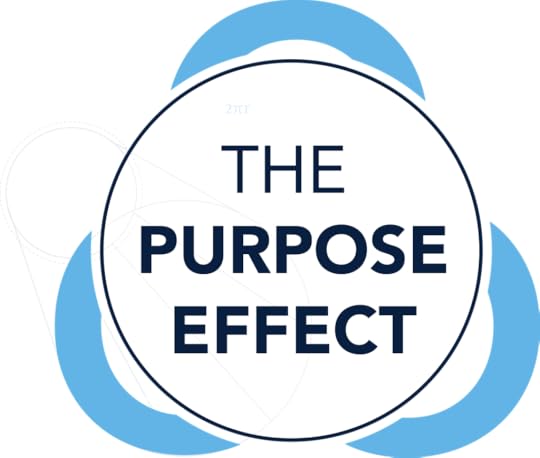 My next book, The Purpose Effect: Building Meaning in Yourself, Your Role and Your Organization is a three-way relationship between an individual’s personal sense of purpose in life, the organization’s purpose and a person’s purpose in their role at work. When all three aspects of purpose are properly defined, are well aligned, and function in partnership with one another, then the employee, the organization and society mutually benefit. When they are not, it can lead to significant damage in society and in the organization. The Purpose Effect is the pattern I have exposed.
My next book, The Purpose Effect: Building Meaning in Yourself, Your Role and Your Organization is a three-way relationship between an individual’s personal sense of purpose in life, the organization’s purpose and a person’s purpose in their role at work. When all three aspects of purpose are properly defined, are well aligned, and function in partnership with one another, then the employee, the organization and society mutually benefit. When they are not, it can lead to significant damage in society and in the organization. The Purpose Effect is the pattern I have exposed.
Think of it as a three-legged barstool. If one of the legs is broken or uneven, either an individual ends up crashing to the ground or there is a perpetual wobble, prompting a feeling of uneasiness, of disequilibrium. Such a lack of balance in the workplace can result in personal disengagement, disbandment of a team, or in the direst instance, the end of the organization itself. Those who lack direction in these situations, simply go through the motions, longing for the day when their opinions and ideas mattered, helpless as senior leaders pursue an organizational purpose that has no meaning for them personally. Any lack of alignment between the three categories of purpose—the barstool legs—can have devastating consequences at both an individual and a collective level.
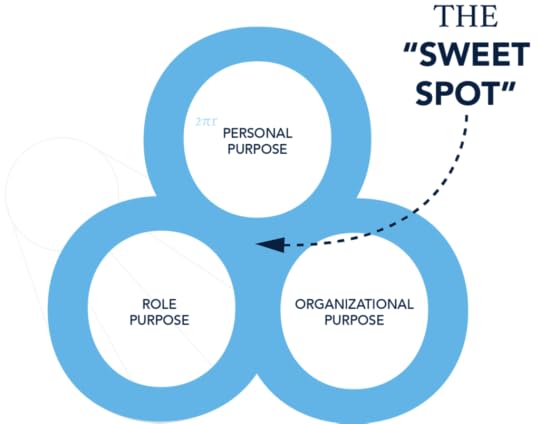 The Purpose Effect (publishing May 10, 2016 – pre-order now if you like) chronicles my thesis and findings. It draws on research, interviews and first-hand leadership experience, establishing a potentially positive and reciprocal connection between three distinct categories of purpose:
The Purpose Effect (publishing May 10, 2016 – pre-order now if you like) chronicles my thesis and findings. It draws on research, interviews and first-hand leadership experience, establishing a potentially positive and reciprocal connection between three distinct categories of purpose:
Personal purpose
Organizational purpose
Role purpose
If all three categories of purpose can come to fruition—if there is a positive interconnection between the three distinct definitions of purpose—the benefits should be felt by employees, teams, the organization, customers, owners and, perhaps most importantly, society as a whole. We can refer to this balanced state as the “sweet spot.”
While the book is not out until next year, I was fortunate in 2015 to be asked to deliver a TEDx Talk. I took the opportunity to unleash The Purpose Effect in the now legendary, 18-minute TED format. Thank you to the entire TEDxSFU team for allowing me the chance to speak about something I am very passionate about … PURPOSE!
Dan's Related Posts:Perhaps the Purpose of an Organization?My PurposeWhat Should The Title Of My Next Book Be?Corporate Culture in a Venn DiagramMy Definition of Work and an Update on Book Two
November 25, 2015
The Black Friday Shopping Flowchart
As North America gears up for Black Friday, I thought it might be a good idea to design a flowchart … a handy guide to help you decide whether or not you really need (or want) all of that new stuff.
There are often times we do in fact ‘need’ new stuff. I had to buy some new Xmas candles just last week. Today I got gas and some milk.
This flowchart is not anti-capitalism. It is merely a pause for reflection before the madness of Black Friday ensues.
Do you really need it? Or do you simply want it?
When you do have to buy something, are you being a conscious consumer?
I struggle, too.
But all of us can do a better job.
This Black Friday, I choose not to shop.
Dan's Related Posts:Friday Fun: You Don’t Have an Office?Can Humanism Replace Capitalism?Friday Fun: Bendable ScreensFriday Fun: All That JazzFriday Fun: The Difference b/t Apple & Microsoft Is …
November 18, 2015
Building Your Headquarters To Boost Employee Engagement
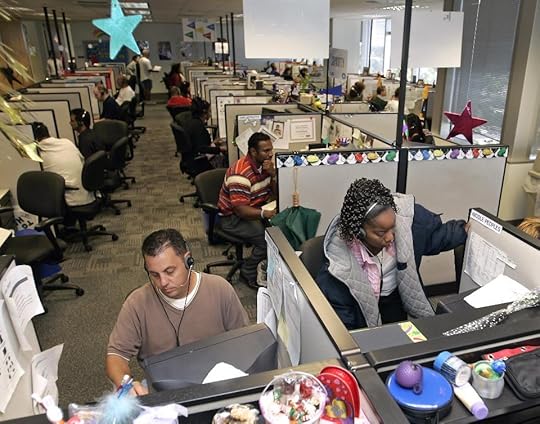 (AP Photo)
(AP Photo)We have all entered an office building at one time or another and remarked, “This is a hellhole.”
You may be aware of the type of structure I am referring to. Their features could have included the following:
Cubicles built by the makers of tanks and nuclear bunkers;
Hallways adorned with orange, flea-infested industrial carpet;
Paintings of Queens and posters of uninspiring figureheads hung from the walls;
Bathrooms mocking themselves as actually usable;
Staffrooms and cafeterias possessing three chairs for a team of fifteen;
Windowless meeting rooms with a phone, but not one that had a hands-free speaker option.
When an employee spends 40 hours a week in a building that is not only lackluster, it is damaging employee commitment and morale, then perhaps it is time to rethink your organizational culture strategy.
I have been to many office buildings throughout my career. Whether in North America, Europe or Australia, I have witnessed the good and the not-so-good of corporate headquarters. I once sat in the foyer of a company waiting for my meeting to start. Out of the corner of my eye I saw two employees standing on a table in a meeting room trying to connect their laptop to the LCD projector that was hanging overhead. It demonstrated teamwork, but I thought it might be a wee bit of a safety hazard, too.
Another time, when I was being led from the front desk to a meeting room, my escort apologized for the lighting. “Sorry it is so bright in here,” she said. “We can’t seem to figure out how to dim any of these lights.” If by bright she meant like the 7,000-watt xenon lamps fixed atop the Luxor hotel pyramid on the Las Vegas Strip, then yes, I would have agreed with her.
But when an organization does indeed create an office environment and atmosphere that emits harmony, collaboration and a sense of vitality throughout its confines, there is an undeniable and infectious culture that manifests.
Take for instance Google and its famous Googleplex .
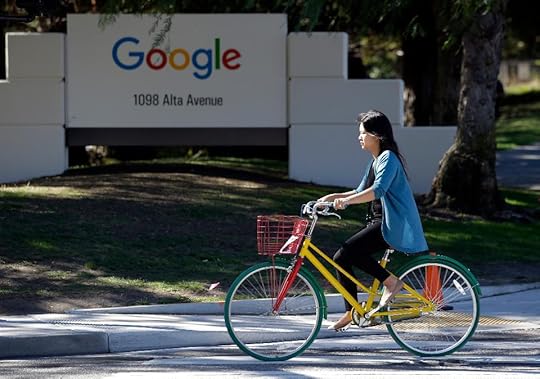 In this Oct. 20, 2015 photo, an employee rides a company bicycle outside Google headquarters in Mountain View, Calif. (AP Photo/Marcio Jose Sanchez)
In this Oct. 20, 2015 photo, an employee rides a company bicycle outside Google headquarters in Mountain View, Calif. (AP Photo/Marcio Jose Sanchez)Located at 1600 Amphitheatre Parkway in Mountain View, California, Googleplex is the corporate headquarters of Google. Its sprawling 3 million square feet campus houses a great many of its global workforce (roughly 19,000 people according to the San Francisco Chronicle) and was also the scene for the comedy movie, The Internship starring Vince Vaughn and Owen Wilson.
But what is it that makes Googleplex so unique? Why is it written about so often?
When I visited, sure, you notice perquisites pretty much everywhere. There are car washes, dry cleaning drop-off areas, pop-up hair salons, fitness centers, mobile libraries … and food in just about every other corner. The kitchens are spectacular offering breakfast, lunch and dinner across an array of menu items that could compare with some Michelin restaurants. But Googleplex is more than simply perquisites like the use of bikes to ride across the campus. There is a vibe at Googleplex, a sense of community.
In his book, Work Rules: Insights From Inside Google That Will Transform How You Live And Lead, Laszlo Bock (Google’s head of People Operations) writes, “A sense of community helps people do their best work just as surely as increasing efficiency does by sweeping away minor chores and distractions.” Buildings can create this sense of community. If they are built right, if the buildings permit collaboration and openness, good things can result from both the organization’s culture and its results.
Bock continues, “All of these programs work to create efficiency, community, or innovation. Some might argue that this is a gilded cage, a trick designed to convince Googlers to work more or stick around longer. But that fundamentally misunderstands not just our motives, but also how work happens in companies like ours.”
My place of work, TELUS, is another example. It has been refurbishing its buildings and erecting brand new structures for several years now.
 TELUS Garden lobby. October, 2015.
TELUS Garden lobby. October, 2015.TELUS Garden is one of those. Just opened this fall, the building is a $750-million, one-million-square-foot development made up of a 24-floor office tower—and new corporate headquarters for TELUS—pitted alongside a 53-floor residential tower that will open in the spring. Interestingly, almost half of all commercial condominium units in the residential tower were purchased by TELUS team members. The new headquarters is located in the heart of downtown Vancouver. Not only is it creating a renewed sense of collaboration and spirited teamwork for the 1000 team members that permanently work out of this building (and hundreds more dropping in as needed) the office tower is submitting for the new more stringent Leadership in Energy and Environmental Design (LEED) Platinum Certification, a first in Canada.
One of the standout sustainable features of the development is the innovative district energy system nested inside the building. This system will permit CO2 emissions reductions by over a million kg per year. By recapturing heat from TELUS data centres housed onsite, it allows the new headquarters to reduce its conventional energy demand for heating and cooling by over 80 percent. The development partner of TELUS Garden, Westbank, says, “Of all the building features that contribute to the LEED Platinum certification, the district energy system alone makes the building the most energy efficient piece of real estate in Vancouver.”
Then there is an Innovation Centre, where the company and its team members try out raw ideas and incubate new concepts that will eventually benefit the customer base. Cantilevered spaces hanging over major road arteries maximizes the vertical space and square footage of the building itself. The building boasts more than 10,000 square feet of garden space – that doubles as outdoor workspace – across six different levels with over 1,000 species of plants and trees. Next season, team members will grow and harvest produce onsite. The top floor houses Vancouver’s largest array of solar panels (nearly 300 in total) that power the external lighting of the building, not to mention the installation of a rainwater capture system that is used to irrigate all of the various gardens found throughout the building.
Of course as you would expect in a brand new headquarters, there are collaborative and private meeting rooms, open seating areas, shared work stations, outdoor terraces, kitchens and all sorts of amenities. The building features unique design elements, such as a raised floor system, 100 percent fresh air ventilation, radiant heating and cooling, higher than average ceiling heights and operable windows. Imagine that. An office tower where you can open the windows.
What does all of this mean?
Whether at Google or at TELUS, a building can have a wonderful and positive effect on the culture of your organization. In this shift toward flexible work—where employees are often mobile or even working from home 90 percent of the time—going into “the office” should feel welcoming, warm and inviting. If your buildings are closed, dilapidated or relics from the 1970s, it may be having detrimental effects on your culture. It may be causing disengagement, reduced productivity and even a lack of innovation. It cannot feel great for those ‘stuck’ working in the building 100 percent of the time. And for those who are mobile or working from home, why would they want to come into the building if it’s not inviting?
For those that work full-time or part-time in the building, having access to amenities and collaborative space while being afforded the luxury of working in a sustainable building may actually increase employee engagement. A 2012 report by Engage for Success, for example, suggested the physical work environment and the buildings where employees work create the basis in which ‘employee commitment’ begins. It suggested that any positive changes to the physical environment of an employee’s workspace increases physical comfort and wellness, thus creating an environment that is conducive to increasing employee engagement.
Indeed, a study conducted by University of Notre Dame management professors Edward Conlon and Ante Glavas investigated the relationship between corporate sustainability and financial performance by virtue of analyzing 562 US banking branches (93 were LEED certified and 469 were non-LEED). The researchers found those working in LEED-certified buildings were “more productive and engaged in their work.”
Can a building improve employee engagement?
It almost sounds like a moot question. The flipside is whether a stodgy building replete with fluorescent lighting, rickety chairs and windowless meeting rooms—possessing a lack of perquisites and amenities—is how employees want to be treated in today’s age of employment choice.
It is not a question about employee engagement.
It is about whether or not your building is mimicking your corporate culture.
Dan's Related Posts:“Oh, you’re one of those. You want to work anywhere, anytime.”Try Implementing Flexible Work Options to Increase Employee EngagementFlexible Working WorksRedefining the Social EmployeeBook Review of WORK RULES: Insights From Inside Google
November 10, 2015
To The Establishment
The sky is ours. Let’s fly.
— Dan Pontefract (@dpontefract) November 11, 2015
The creation of an individual’s personal purpose is, above all, what we call life.
— Dan Pontefract (@dpontefract) November 11, 2015
To those cut loose by the organization, by the establishment, carry on. The sky is yours … fly.
— Dan Pontefract (@dpontefract) November 11, 2015
The bird is free from the cage. Soar like a canary does escaping the coal mine. Blue skies ahead. Fly.
— Dan Pontefract (@dpontefract) November 11, 2015
Your rival is only ego. Fly.
— Dan Pontefract (@dpontefract) November 11, 2015
Don’t call me an asset. Don’t call me headcount. Don’t call me an employee. I am a bird. Fly.
— Dan Pontefract (@dpontefract) November 11, 2015
There is an “I” in profit, but not in fly. So, fly.
— Dan Pontefract (@dpontefract) November 11, 2015
For we are in perennial motion, with purpose, constantly tending to the sky. Fly.
— Dan Pontefract (@dpontefract) November 11, 2015
“It’s okay, we’ve all seen better days It’s okay, you don’t have to run and hide away It’s okay It’s okay, yeah we love you anyway”
— Dan Pontefract (@dpontefract) November 11, 2015
“This is my chance, this is my life And my opening hour This is my choice, this is my voice There may be no tomorrow”
— Dan Pontefract (@dpontefract) November 11, 2015
To the establishment … You know what to do.
— Dan Pontefract (@dpontefract) November 11, 2015
Fly.
— Dan Pontefract (@dpontefract) November 11, 2015
Dan's Related Posts:A Twitter Conversation With Myself About Culture and CetaceansCalling Frederic Laloux Of Reinventing OrganizationsIn 2015, Will I …Flat Army Graphics on SlideshareWhen Power Overthrows Common Sense
October 24, 2015
A Lesson On Balancing Purpose With Profit
 When I grew up in the 1980’s, I was both amused and bemused on the date of April 23, 1985. New Coke was introduced to the world on this day. Back when I had hair, parading the streets of a rough and tumble neighbourhood in Southern Ontario, the children were either Catholic or Protestant, Toronto Maple Leaf or Montreal Canadiens fans and of course Coke or Pepsi drinkers.
When I grew up in the 1980’s, I was both amused and bemused on the date of April 23, 1985. New Coke was introduced to the world on this day. Back when I had hair, parading the streets of a rough and tumble neighbourhood in Southern Ontario, the children were either Catholic or Protestant, Toronto Maple Leaf or Montreal Canadiens fans and of course Coke or Pepsi drinkers.
I was firmly in the Coke camp.
“New Coke,” I gasped to my friends. “This must be a practical joke. How could they do such a thing to us?” We immediately started hoarding cans of “Old Coke”, saving them for the coming Coca-Cola brownout.
As we now know, it was not a joke, rather (arguably) one of the strangest ideas ever to surface and be executed on in the corporate world. Mercifully, the company pulled the plug on “New Coke” and brought back “Old Coke” as “Classic Coke” and balance was restored. The shift back to “Classic Coke” was so much of a controversy that ABC News’ Peter Jennings actually interrupted a daytime soap opera (General Hospital) to report the change in direction at Coke.
Coca-Cola Enterprises (CCE) is one of the world’s largest bottlers and distributors of Coca-Cola. They are a separate entity to the mother ship of all things Coke in Atlanta, known as The Coca-Cola Company. CCE serves the countries of Belgium, France, Great Britain, Luxembourg, Monaco, the Netherlands, Norway, and Sweden, handling roughly 8 percent of Coca-Cola’s global volume of sugary drink distribution. That makes CCE the world’s third largest distributor of Coke products.
Up until February 24, 2010, CCE handled and distributed all bottles and cans of Coke. But by 2010, the Coca-Cola Company – the aforementioned mother ship – paid over $15 billion to CCE to take back the delivery of Coca-Cola products to North Americans. CCE’s business became solely Western Europe based and the mother ship in Atlanta began to wrap its hands around North America distribution.
On August 6 of this year, CCE announced it was merging with Coca-Cola Iberian Partners and Coca-Cola Erfrischungsgetränke AG to form Coca-Cola European Partners, creating the world’s largest independent Coca-Cola bottler based on net revenues. Regarding the merger, Muhtar Kent, Chairman and Chief Executive Officer of The Coca-Cola Company said, “With the strong leadership that will be assembled from across the three organizations, Coca-Cola European Partners will be well-positioned to deliver better and more effective service to customers throughout Western Europe and drive profitable growth across multiple beverage categories.”
Customers and profits are important. But importance is also found by serving other stakeholders including society, communities, the environment and employees. I bring up this background and history for a couple of reasons.
You may think Coca-Cola is one giant company. It’s not.
More importantly, I think it is time for “New Coke” to resurface.
Not the ill-fated “new” cola drink from 1985.
I have a challenge for this new organization, Coca-Cola European Partners (CCEP), and its CEO, John F. Brock. The challenge is to truly demonstrate that the new company can become a “New Coke” organization depicting its mission that puts purpose on par with profit. In doing so, CCEP can showcase to organizations of any ilk that the goal of a for-profit organization is not shareholder supremacy.
Maybe all organizations that are profit in nature can become a “New Coke” organization.
Let me explain.
First off, Mr. Brock is already demonstrating aspects of the purpose and profit balance with the former CCE organization he used to be CEO of. Despite it being a company that ended 2013 with net revenues of $8.2 billion and net income of $677 million – delivered by approximately 11,750 employees – Mr. Brock began to cultivate an organization that was bringing a greater balance between purpose and profit.
For example, in an external summit it organized called Future for Sustainability, the company partnered with Cranfield School of Management and The Financial Times to conduct research on the future of sustainability, where it found:
88% of current CEOs and 90% of future leaders believe businesses should have a social purpose
19% of future leaders think businesses already have a clear social purpose, compared to 86% of current CEOs
Kudos go to Brock for not only sponsoring research on the future of sustainability and the social enterprise, but for organizing the summit itself. To provide further insight into Brock and his belief in combining purpose with profit, read what he had to say in the days before the summit kicked off:
“I have been a firm advocate of two principles: that business must contribute to society and the environment, and that every investment a company makes should return value to the business. I do not believe these principles are mutually exclusive – in fact, I believe they are mutually beneficial.”
It may be a statement that could be heeded by CEOs and Directors from every for-profit organization in existence. Business must contribute back to society, its employees and the environment, but it suffers from the lingering hangover of “Reaganomics” and the myopic view that increasing shareholder return is the only goal of an organization. In fact, Brock states as much later in his piece:
“We face many obstacles on the journey towards combining profit and purpose. The market system in which we operate will continue to look for and reward outstanding financial performance – it is our job to better define and communicate the financial benefits of integrating social and environmental impacts into business strategy to this audience.”
Indeed, a “New Coke” organization needs to rethink the purview of being an “increasing shareholder value” only company.
In a study with 75 multinational CEOs called The UN Global Compact-Accenture CEO Study on Sustainability 2013: Architects of a Better World, 79 percent of CEOs believe better sustainability and purpose practices will lead to increased competitive advantage in their industry. That is the good news. Those same CEOs, however, believe the current economic climate and competing priorities create obstacles to achieving what they know is the ‘right thing to do’, thus preventing a better balance of purpose with profit. Again, it is the stock market and financial forces that becomes a hindrance to real change.
Brock also states:
“Ultimately, we are in unchartered territory; society is facing bigger, more serious challenges than ever before and there is an expectation on business to play a central role in addressing them. The successful companies of the future will combine profit with purpose, and successfully define their broader contribution to society and the planet.”
It is no wonder Brock’s own study with Cranfield School of Management and The Financial Times surfaced a 67-point gap between the views of current CEOs and future leaders when it comes to purpose in the organization. Not only is change hard, a balance between purpose and profit seems to be playing out as a new form of greenwashing. CEOs might talk a good game about combining purpose and profit, but not much is actually happening due to the entrenched “market system” and this sort of thinking claiming to be “uncharted territory.” Perhaps we can call it “purpose-washing”.
But I believe it is time for “New Coke”.
For John F. Brock of Coca-Cola European Partners, perhaps it is time to not only talk about purpose with profit; it is time to put a stake in the ground as it puts together the newly merged company. Take for example what Brock’s former organization, CCE, describes as its primary objective:
“Our primary objective is to deliver a superior investment return to our shareowners through consistent increases in long-term operating cash flows and profitable increases in sales volume.”
If – as Brock states – purpose and profit can become “mutually beneficial”, I am wondering if the new leadership team will create a “purpose statement” rather than a “mission statement” that mistakenly depicts “superior investment return” as its number one priority. This is merely “Classic Coke” vernacular. I would expect someone like Brock to engender himself in 2015 to updating the primary objective of the new organization, CCEP, to include both purpose and profit. This action would back up his previous thoughts around purpose.
The Future for Sustainability summit developed an infographic that outlined seven key steps for leaders to take, as it pertains to the shift to a more balanced purpose and profit-based organization. What is interesting is the seventh step, which suggests leaders must “educate themselves” and “change their mindsets” when it comes to combining purpose with profit.
Again, for Brock, I’d love to see him go the extra kilometer and not only distribute such a powerful infographic, but educate his new leadership team to change the mindsets at CCEP such that their primary objective does in fact become a proper balance of purpose and profit. Who are the true stakeholders of CCEP? Is it solely shareholders, or does it include customers, employees, partners, the supply chain and society in general?
It is time to let go of the “Classic Coke” mindset and the myopic view that an organization’s purpose is solely to increase shareholder value. Profit must blend with purpose going forward. CCEP can become a leader arguably following in the footsteps of “purpose and profit” organizations such as Unilever, Virgin and Whole Foods.
“New Coke” … you can’t beat the real thing.
Dan's Related Posts:My Hopes for the Drucker Forum #gpdf14That Decision Is Above My Pay-GradeWhat Should The Title Of My Next Book Be?Can Humanism Replace Capitalism?A New Hero of Mine, Alfredo Moser
October 17, 2015
We Can Put The Word ‘Can’ Back In Canada
Should I?
Should I opine about Monday’s general election in Canada?
I am apolitical … usually. But not this year. Not this time.
Since 2006, the Conservative Party of Canada, led by Stephen Harper, has formed the government of my country. The first two terms were a minority government whereas since 2011, the Conservatives have held the majority. Mr. Harper is gunning for a fourth term as prime minister.
I can no longer remain silent.
I am concerned, for I believe Mr. Harper and the Conservatives have created an ethos of “cannot” as opposed to an atttude of “can“. The former is something I do not support, and can no longer sit quiet with. The former is the status quo. It is time to suggest we can become Canadian again.
This “cannot” aura that Mr. Harper has introduced is affecting my country’s prosperity, external brand, and cultural identity. This “cannot” demeanor must be eviscerated for it is as untenable as unlimited oil from the Earth’s underground.
Canada is a country of people—and always has been a country of people—with a “can do” sense of being, of action. We are not a nation of disenfranchised, disenchanted or divisive people.
It is not a “cannot” country.
The good news is that it can be changed.
We can open our doors to strangers, newcomers and refugees. We cannot (and do not) turn our backs to those that have always made our country the melting pot envy of millions. We can open our minds, and we do because that is how Canada prospers. We are a nation of immigrants, and can understand why it’s so. We can and do welcome people into our country—like Calgary mayor Naheed Nenshi—not because of quotas but because it is what Canada does. Canada can become inclusive, again.
We can enter into international conflicts—such as Bosnia, Kosovo, Cyprus or Haiti—not to flex our muscles but to keep the peace. We can reclaim the badge of peacekeeper, the noblest of Canadian traits. This is what Canada does. This is what we can do. We cannot mock a nation or a culture. We cannot ban niqabs at citizenship ceremonies for that is not Canadian. We can be—as has been the fabric of Canadian identity since 1867—a nation full of compassion, consideration and empathy. Canada cannot continue to remain divisive.
It cannot believe the sword (and arrogance) is mightier than the heart.
We are Canada. We cannot be bullies. We can become leaders, again. We can love, and be loved, again.
We cannot lead by Stalinesque virtues. We cannot govern by undemocratic ideals. We cannot introduce unethical spying and turn a blind eye. We cannot prorogue out of convenience. We cannot pretend things are better economically since 2006. We cannot forget we can.
We can regain the world’s trust. We can regain each other’s trust. We can remember what it was like to be proud to be from Canada.
We can go back to being Canadian. We can go back to being proud Canadians.
We can reinsert the word “can” into Canada.
How can we?
Vote. Monday, October 19, 2015.
Dan's Related Posts:O Canada My CanadaTerry Fox, My HeroRise of the Woman?Kudos Jacques Godin, an Engaged Air Canada EmployeeAn Example of the Flat Army CLAM in Action: BC Ideas2Action
October 10, 2015
Lessons In Culture From United Airlines
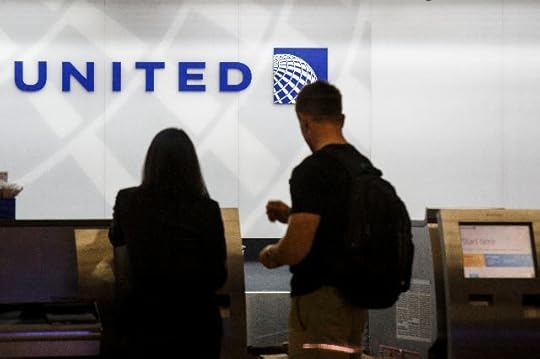 Photographer: Patrick T. Fallon/Bloomberg
Photographer: Patrick T. Fallon/BloombergThis week I flew from Las Vegas to San Francisco on United Airlines. Because United is affiliated with the Star Alliance group—and I’ve fallen head-deep into the business travel trap of collecting air miles—when I’m trying to get back to British Columbia and Air Canada does not fly direct, I am forced to use United Airlines. I have done so for the better part of fifteen years.
Like many other customers, I would not consider myself a raving fan of how United operates.
When I approached the counter this week in Las Vegas to sort out a boarding card issue, I took it as an opportunity to ask the agent how things are going at United these days. Specifically, I wanted to know if she felt their new CEO, Oscar Muñoz, would bring any change to the company, its culture and its operating practices.
“Oh I do hope so,” the lovely agent replied. “I’ve been here for more than 20 years, and I’ve never seen it this bad.”
Evidently, neither has its customer base (138 million in 2014, according to United) or those who track airline quality and service.
Take for instance the Airline Quality Rating 2015 report. In its 25th year of reporting on airline performance, the 2015 version does not indicate things are significantly improving for United Airlines. In fact, things seem to be sliding even further backwards. A few data points:
United’s 2014 overall Airline Quality Rating (AQR) score fell to -1.62 from -1.43 in 2013
On-time arrival performance declined from 79.3% in 2013 to 76.0% in 2014
Mishandled baggage rate increased from 3.47 per 1,000 passengers in 2013 to 3.67 in 2014
The rate of customer complaints increased to 2.71 in 2014 compared to 2.14 per 100,000 passengers
Skytrax is another service that surfaces interesting data points about United Airlines.
After over 3,500 passenger reviews on Skytrax, United has earned a 3/10 rating from those customers. The comments are none too flattering either. “Flight attendants seemed unapologetic and were even borderline rude”, “I felt like an inconvenience, not a customer,” and “I honestly can’t comprehend with human logic how this company still exists,” are but a smattering of comments lodged on the Skytrax site … this week!
Skytrax also issues what it refers to as “airline ratings”. These ratings come from an in-house audit team consisting of “dedicated, experienced air transport research professionals.” These professionals put together a rating system that the airlines use to gauge their product, but also to use for marketing purposes. The range is between a one-star rating to a five-star rating. Skytrax has awarded United Airlines a three-star rating, for “delivering a fair quality performance that conforms to an industry “average” of acceptable product and service standards.”
As an infrequent customer, that pretty much sums up my impression of United Airlines. It is an average experience, both of its product and its service. Three points out of ten is a bit harsh (in terms of the aggregated customer feedback score), but the airline is certainly not in the customer service vicinity of Singapore Airlines or Cathay Pacific. Both of these possess 5-star ratings from Skytrax. I have had the pleasure of flying on both airlines and can vouch for an incredible customers-first ethos. They truly set the bar for an incredible flying experience.
But if you are a United Airlines customer—and a member of the Star Alliance family—there may be hope on the horizon.
On Labor Day weekend of 2015, Oscar Muñoz became CEO of United Airlines. Regardless of the circumstances that led him to the position, after a month on the job, it seems he is determined to fix what ails this $38 billion company. It’s a company that operates over 4,700 daily departures through its 84,000 employees.
It seems Mr. Muñoz wants to unite its corporate culture, in an attempt to improve its operations.
In other words, he aims to tackle and develop employee engagement, to increase customer service, to improve its business results.
One of his first public initiatives was to launch United Airtime.
The site is Mr. Muñoz’s attempt to “to connect directly with United’s customers and employees to answer your questions and get your feedback about how we can become the world’s best airline.”
I find it quite interesting. This is not a site for customers only. It’s for both “customers and employees”. Muñoz could have built a site tucked safely behind the firewall of United Airline’s corporate intranet for employees only, but he didn’t. It’s an open site, and through a video that accompanies the site, he is laying things on the line, pleading for people to provide feedback and suggestions. “Most importantly,” he states in the video, “I promise to report back on how those ideas are being turned into actions.”
Furthermore, in an interview, Muñoz said, “I would think we could want to offer a better product.” In fact, with respect to United employees, he suggested that they had been allowed “to be disengaged, disenchanted, disenfranchised — the three nasty D’s. I’ve got to win all (of them) back.” No doubt as a previous United board member, he had flown United in the past and noticed these three nasty D’s on occasion.
If that were not enough, on October 1, 2015, he orchestrated the delivery of full-page advertisements in several American newspapers, apologizing for the current state of affairs at United. The ads start out, “To our passengers, my fellow employees, and the communities where we live and work.” It’s another example of how Muñoz seems committed to uniting its culture, such that it serves the interests of all of its stakeholders (customers, employees and the community) far better than it has been in recent years.
Like many customers of United Airlines, I hope things improve. I know it will not happen overnight. Culture change is not a light switch anyone can magically press to inculcate the right behaviors and attitudes. As someone that advocates for organizations to fuel its future by an engaged and purpose-driven workforce—comprised of team members who genuinely want to put its customers first—I am intrigued. I’ll be keeping a close eye on United Airlines, and wish Muñoz and the entire organization nothing but good luck in their task ahead.
I know there is one employee in Las Vegas who is certainly welcoming the change.
__________
Dan Pontefract is the author of FLAT ARMY: Creating a Connected and Engaged Organization and is Chief Envisioner at TELUS Transformation Office. His next book, The Purpose Effect, will publish May 10, 2016.
Dan's Related Posts:Why Don’t We Tip Flight Attendants?Air Canada Isn’t Collaborating With Its EmployeesThe Leadership Collapse of Manchester United“Oh, you’re one of those. You want to work anywhere, anytime.”Kudos Jacques Godin, an Engaged Air Canada Employee
September 11, 2015
Automation For The People
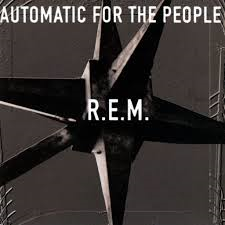 Athens, Georgia, based restaurant Weaver D’s Delicious Fine Foods was once honored by an American Classics awards to recognize “good, down-home food” and “unmatched hospitality” – for its “spot-on fried chicken, sweet potato casserole, buttermilk cornbread, and … signature squash casserole.” G.P. Dexter Weaver, the legendary owner, wants its service to be known as “automatic for the people”, a term fellow Athens rock band R.E.M. used as an album title.
Athens, Georgia, based restaurant Weaver D’s Delicious Fine Foods was once honored by an American Classics awards to recognize “good, down-home food” and “unmatched hospitality” – for its “spot-on fried chicken, sweet potato casserole, buttermilk cornbread, and … signature squash casserole.” G.P. Dexter Weaver, the legendary owner, wants its service to be known as “automatic for the people”, a term fellow Athens rock band R.E.M. used as an album title.
Wherever one looks researchers are predicting that “automatic for the people” is morphing into something we might coin “automation for the people”.
Researchers at the University of Oxford indicated 47 percent of employees in the U.S. are at risk of losing their jobs due to automation. In Australia, a recent report by the Committee for Economic Development of Australia (CEDA) suggests 40 percent of all jobs — more than 5 million— face the likelihood of being replaced by computers in the next 10 to 15 years. It is no better in the United Kingdom either. Deloitte pointed out that 35 percent of all jobs across the U.K. will disappear by 2035. The authors further state “jobs paying less than £30,000 a year are nearly five times more likely to be lost to automation than jobs paying over £100,000.”
Perhaps these predicted twists will end up becoming “automatic for the unemployed.” If you believe the prognosticators, society might be left with 40 percent of the workforce unemployed, or underemployed.
Erik Brynjolfsson and Andrew McAfee, in their recent book The Second Machine Age, argue that automation and advanced technologies are root causes to the widening income gap. In 2003, Maarten Goos and Alan Manning coined this phenomenon “job polarization”. Brynjolfsson and McAfee suggest that such advances in concepts such as robotics and artificial intelligence may help to increase overall productivity, but it results in an ironic lack of job creation.
Indeed, the current state seems to have become “automation against the people.”
But there are those who believe this sort of advanced technology can actually accrue benefits to humans.
David Autor, economics professor at the Massachusetts Institute of Technology is a firm believer that the so-called “smart machines” are not that smart and it is the tacit forms of knowledge that humans naturally possess that ensure we will forever remain “automatic for the people”. In a paper published in 2014, Autor presented many points suggesting automation is a good thing for society.
He cautioned that human capital investment “must be at the heart of any long-term strategy for producing skills that are complemented rather than substituted by technology.” He argued that job polarization will eventually disappear because “many of the middle skill jobs that persist in the future will combine routine technical tasks with the set of non-routine tasks in which workers hold comparative advantage” including behavioral attributes such as adaptability, problem-solving, interpersonal interaction and flexibility.
Perhaps the future Autor describes has already arrived.
Autonomous haulage is beginning to take shape in the harsh climate of Northern Alberta throughout the oil sands. Gigantic $150 million trucks are not only expensive, they can be dangerous. A lot can go wrong when 8000 tonnes of dirt is moved 365 days a year by humans. Before self-driving trucks, there were normally four human drivers for each truck, and one mechanic for every 4-6 trucks. It was labour intensive, risky work.
My organization, TELUS, a $12 billion Canadian telecommunications firm, has been working with the oil companies to create pervasive wireless coverage that permits self-driving trucks to operate in those harsh conditions all-day, every day. This has decreased collisions, rollovers and accidents because the autonomous driving error rates are lower than humans.
Improving safety has been a key motivator for the oil companies – not the elimination of jobs. In fact, oil companies encourage workers to achieve their mechanic’s license –to safeguard the 24-hour cycle needed to keep the new trucks running. Perhaps this is an example of Autor’s point about comparative advantage. It is not as though a mechanic’s role can be automated. The oil companies need humans to fix an offline truck resulting in driver jobs being shifted to mechanic jobs.
Within TELUS, “automation for the people” is being meshed with the “automatic for the people” customer service ethos that Dexter Weaver defined earlier.
The team behind much of our client experience processes developed “Next Best Action” that uses a combination of big data, artificial intelligence and automation to improve the entire customer experience.
“Next Best Action” ensures call center agents and team members in our face-to-face stores have the details to be far more proactive – and arguably human – with a customer’s inquiry than ever before. For example, if a client calls into the customer care team, there is automated logic that then routes the call to the right person in the right department saving time for both sides. Data is constantly being fed into a predictive analyzer which speeds up the potential to solve a customer issue. The opportunity is to merge automation and artificial intelligence with a far more customized human touch.
The goal is not to replace call center or store agents with automation; it is using the advanced technologies we continue to develop and invest in to further improve the overarching customer experience with our team members.
But might those computers ever completely take over?
I asked David Autor if organizations should be worried about the so-called technological singularity, where computers and robots might learn how to redesign and improve their existing functionality, to ultimately become better than humans. His response said it all. “No, they should not be worried,” Autor said. “The machines work for us. If they can ultimately do our jobs for us, then we are richer not poorer as a result.”
Autor also introduced me to the observations of economist, computer scientist, and Nobel laureate Herbert Simon, who wrote in 1966 during another time of automation anxiety: “Insofar as they are economic problems at all, the world’s problems in this generation and the next are problems of scarcity, not of intolerable abundance. The bogeyman of automation consumes worrying capacity that should be saved for real problems.”
Put differently, “automation for the people” has been around for a long time.
I have never visited Weaver D’s Delicious Fine Foods restaurant yet, but when I do get there, I know there will be a smiling human being serving me. Indeed, “automatic for the people” will be sticking around in perpetuity, most likely assisted by “automation with the people”.
Dan's Related Posts:Stack Ranking the RobotsHumans Should Aim To Be The Next UsTry Implementing Flexible Work Options to Increase Employee EngagementFlexible Working WorksThe Simple Act of Trusting
September 2, 2015
A Whole Lotta Learning And Love
In the spirit of “working out loud” I’m resurfacing long enough to capture a few of my thoughts that have been gnawing at me since I decided to check out from all things ‘social’ in early July.
While I have dearly missed my connections and network in various social channels, ironic as it has seemed to me, it has been a worthwhile experience fully checking out and focusing my efforts on book writing and reading.
I’ve cheated a few times and checked in on certain things I might have been tagged in, but perhaps that’s a by-product of the morphine drip that is ‘social’.
Some people have actually noticed I’m not using social media these days — by virtue of sending me an email, text or phone call to see if I am alive — and to those that have inquired, thanks so much, I am doing just dandy!
PS. I even publicly joined Instagram. (i.e. my private/anonymous account was deleted)
My writing? Clearer. Happier. Positive. (of course it’s still an endless nightmare of being far too conversational and not ‘business-like’, but like Bob Dylan once said, “That’s my style, man.”
My mood? Clearer. Happier. Positive. (of course it’s still an endless nightmare of goat attacks all day all the time, but at some point in the future those investments made in the 12-, 10-, and 8-year old kids will have to pay off.)
The next book? Honestly, I am loving where it is going. 92,000 words will become 65,000-ish. 13 chapters will become 8. Additional stories (new, updated and forgotten) are being woven into the plot. A new model magically surfaced that made everything crystallize and come together. There is a new title and sub-title (to be divulged at some point) and a new publish date – May 10, 2016. I received out-of-this-world face-to-face feedback from my John Lennon friend in July, and in full disclosure, am now working with George Harrison (aka @IndaloGenesis) on the overall structure and flow. (He is fab – if you are writing a book, ring him up.)
 All in all, as hard as it was to literally say, “Stop the Press” in late June regarding my second book, I could not be in a more fulfilling, flourishing and fantastic state of mind.
All in all, as hard as it was to literally say, “Stop the Press” in late June regarding my second book, I could not be in a more fulfilling, flourishing and fantastic state of mind.
The book may still be crap … but I know in my heart that what I have gone through (and where I am at in terms of my emotional state) makes it that much more worthwhile.
I am both learning and loving, again.
Ancora Imparo.
Dan's Related Posts:I’m Showing My Work … My Next Book Is PostponedInstead of Inbox Zero, How About Outbox ZeroFlexible Working WorksTwo Very Incredible & Courageous WomenDid I Just Spam My Entire LinkedIn Network?

